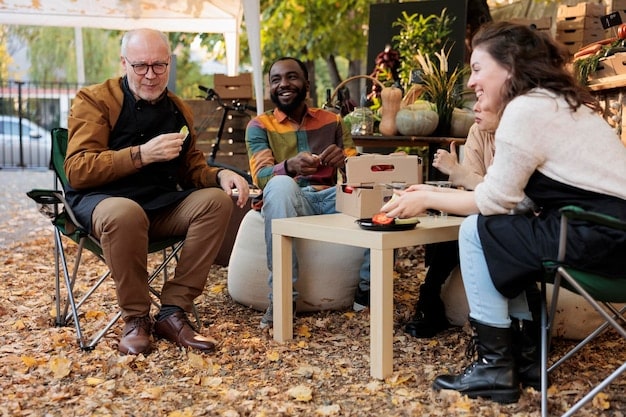Unspoken Rules: US Social Gatherings & American Etiquette Guide

Navigating American social gatherings requires understanding subtle, often unstated etiquette, encompassing greetings, conversations, gift-giving, and departure cues that collectively shape harmonious interactions and reflect cultural nuances.
Ever found yourself at a social gathering, perhaps in the United States, wondering if you’re missing something crucial? Like an intricate dance, American etiquette at social gatherings often involves a set of unwritten rules, subtle cues, and ingrained expectations. To truly engage and feel comfortable, it’s essential to understand What are the Unspoken Rules of US Social Gatherings? A Guide to American Etiquette, a topic that spans from the moment you arrive until your farewell.
decoding an invitation: more than just a date
An invitation to a US social gathering is more than just a piece of paper or a digital message; it’s a social contract. While it provides the basic logistics, understanding its implicit messages is key to a smooth experience. The type of event, the hosts, and even the time of day offer clues about what’s expected.
For instance, an invitation might specify “cocktail attire,” indicating a semi-formal dress code, or “potluck,” which signifies that guests are expected to bring a dish to share. Failing to interpret these nuances can lead to awkward moments, such as arriving over-dressed or empty-handed.
rsvp protocols and timing
One of the most fundamental unspoken rules is the significance of the RSVP. Responding promptly, usually by the requested date, is a sign of respect for the hosts, allowing them to plan accurately for food, drinks, and space. A late RSVP, or none at all, can complicate their preparations.
- Respond by the specified RSVP date, or as soon as possible if no date is given.
- If your plans change after RSVPing, inform the host immediately.
- Never show up with an uninvited guest unless you’ve cleared it with the host beforehand.
Understanding the “host’s role” versus the “guest’s role” dynamic is also critical. Hosts are generally responsible for setting the tone, providing refreshments, and facilitating introductions. Guests, in turn, are expected to arrive on time, engage politely, and contribute positively to the atmosphere without overstaying their welcome.
Ignoring these preliminary steps can mark you as inconsiderate before you even step foot in the door. A well-received guest begins their positive impression long before the event itself, by adhering to the unspoken rules of the invitation phase.
the art of arrival: punctuality without awkwardness
Arriving at a US social gathering isn’t as simple as ringing the doorbell at the exact minute specified. There’s a delicate balance between punctuality and being “too early,” which can be just as awkward as being “too late.” The unspoken rule often suggests a brief grace period.
Typically, arriving 5-10 minutes past the stated start time is considered acceptable, especially for more casual events. This buffer allows the host a few extra moments for last-minute preparations without feeling rushed or surprised by your early presence. For highly formal events, strict punctuality is usually preferred.
what to bring, or not to bring
Bringing a small gift for the host is a common and appreciated gesture, but it’s rarely explicitly requested. This “host gift” should be thoughtful but not ostentatious. It’s important to remember that it’s a token of appreciation, not a contribution to the event’s main offerings.
- A bottle of wine or craft beer.
- A small dessert or quality chocolates (unless you know the host is handling all food).
- A decorative item, like a scented candle or small plant.
- Never bring a dish that requires significant preparation or oven use at the host’s home, unless arranged beforehand.
Upon arrival, a brief and sincere greeting to the host is customary. This is your moment to thank them for the invitation and offer your host gift. Avoid immediately diving into conversations with other guests before acknowledging your host.
The first few minutes set the tone for your presence at the gathering. A polite, considerate arrival demonstrates respect for the host and an understanding of social graces, contributing to a positive experience for everyone involved.
navigating conversations: topics, trust, and tact
Once you’ve arrived and settled in, the intricate dance of social conversation begins. In US social gatherings, conversation is often light, dynamic, and aims to find common ground. Understanding which topics are generally safe, and which to avoid, is a cornerstone of smooth interaction.
Safe topics usually include hobbies, travel, pop culture, and general observations. These allow for easy back-and-forth and can help you discover shared interests. Conversely, deeply personal issues, strong political opinions, or controversial religious views are often best avoided, especially in initial interactions or larger groups.
active listening and balanced participation
A key unspoken rule is active listening. This means more than just waiting for your turn to speak; it involves truly hearing what others are saying, asking follow-up questions, and showing genuine interest. Dominating the conversation or speaking excessively about oneself can be off-putting.
- Make eye contact, but don’t stare.
- Nod occasionally to show engagement.
- Avoid interrupting others while they are speaking.
Body language also plays a significant role. Open posture, a relaxed demeanor, and appropriate personal space contribute to a comfortable conversational environment. Standing too close, having your arms crossed, or constantly checking your phone can send signals of disinterest or discomfort.
The goal is to foster an inclusive and enjoyable atmosphere where everyone feels heard and respected. Mastering the art of conversational nuance is a skill that enhances not only your social interactions but also your ability to connect authentically with others.

food and drink etiquette: the subtle dance of consumption
The role of food and drink at US social gatherings is multi-faceted. It’s both a practical offering and a symbolic gesture of hospitality. Understanding the unspoken rules surrounding consumption can prevent awkward moments and demonstrate your appreciation for the host’s efforts.
Typically, hosts will provide a variety of options, from appetizers to main courses and desserts. The expectation is not to overindulge, but to enjoy the offerings in moderation. Piling your plate high, especially at a buffet, can be seen as impolite or as indicating that you haven’t considered others.
dietary restrictions and offering help
If you have specific dietary restrictions (e.g., allergies, vegan), it’s generally polite to inform the host in advance, allowing them to make accommodations or suggest you bring a suitable dish. However, it’s not the host’s sole responsibility to cater to every dietary need unless explicitly stated.
- Be proactive if you have severe allergies.
- Consider bringing your own safe snack if you’re unsure.
- Never complain about the available food options.
Another common unspoken rule involves offering to help the host. This could be assisting with setting up, serving, or cleaning up after the meal. Even if the host declines, the offer itself is appreciated, demonstrating your willingness to contribute rather than just consume.
The way you handle food and drink reflects not only your manners but also your awareness of the host’s labor and generosity. Being mindful of these nuances reinforces your role as a considerate and appreciative guest, enhancing the overall flow of the gathering.
the thank you and the graceful exit: departing reflections
Knowing when and how to leave a social gathering is as important as knowing how to arrive. The “graceful exit” is an unspoken rule that ensures you leave a positive lasting impression without disrupting the flow of the event or inconveniencing your hosts.
There’s no strict rule for how long you should stay, but common sense prevails. For a dinner party, staying an hour or two after the meal is generally appropriate. For a more casual open-house style gathering, you might stay for a few hours. Avoiding being the first to leave, or the very last, is often a safe bet.
expressing gratitude and follow-up
Before you depart, always make sure to find the host and thank them directly for the invitation and for their hospitality. A brief, sincere statement of enjoyment is usually sufficient. This personal acknowledgment is crucial and should not be overlooked.
- Express thanks directly to the host.
- Avoid lingering at the door, engaging in long goodbyes.
- Consider a follow-up text or email the next day.
In addition to the verbal thanks, a follow-up thank-you note or message (email or text, depending on your relationship with the host) within 24-48 hours is a highly valued, though increasingly less common, gesture. This reinforces your appreciation and acknowledges their effort in hosting.
Your departure is your final act as a guest at the gathering. By adhering to these unspoken rules, you not only show respect for the hosts but also ensure that your presence was a pleasant addition, making them more likely to invite you again in the future.
unexpected scenarios and adaptability: mastering the fluid social landscape
While many unspoken rules provide a framework for American social gatherings, real-life situations are rarely entirely predictable. Mastering social etiquette also involves the crucial skill of adaptability and navigating unexpected scenarios with grace and confidence.
Imagine, for example, a moment where a controversial topic arises. Instead of engaging defensively, a polite deflection or a quick change of subject can diffuse tension. Or perhaps you accidentally spill something; a quick apology and an offer to clean up demonstrate responsibility.
handling mishaps and miscommunications
Mishaps are part of any social interaction, but how one handles them is key. Owning up to a mistake, offering a genuine apology, and attempting to rectify the situation (if appropriate) demonstrates maturity and respect for your hosts and fellow guests.
- Apologize immediately for any faux pas.
- Offer to help or make amends if possible.
- Don’t dwell on minor mistakes; move on gracefully.
Miscommunications can also occur, particularly with differences in communication styles or when dealing with cultural nuances. Seeking clarification politely rather than making assumptions can prevent misunderstandings from escalating.
The ability to remain calm, observant, and respectful in fluid social situations is a hallmark of good etiquette. It shows that you’re not just following rules blindly, but that you genuinely care about fostering a positive and comfortable environment for everyone involved, even when things don’t go exactly as planned.
the nuance of cultural differences: bridging the etiquette gap
Understanding the unspoken rules of US social gatherings is particularly crucial for individuals from different cultural backgrounds. What might be polite or customary in one culture could be misinterpreted or even considered rude in another. Recognizing and bridging this “etiquette gap” is vital for successful intercultural interactions.
For instance, personal space (proxemics) varies significantly across cultures. In the US, people generally maintain a larger personal bubble than in many Latin American or Middle Eastern cultures. Standing too close might be perceived as aggressive or uncomfortable here, whereas it could be a sign of warmth elsewhere.
gestures, eye contact, and vocal tone
Non-verbal cues like gestures and eye contact also carry different meanings. A direct, sustained gaze is often seen as a sign of honesty and engagement in the US, but can be viewed as disrespectful or challenging in some Asian cultures. Conversely, avoiding eye contact might be interpreted as shyness or dishonesty in the US.
- Be mindful of personal space; generally, an arm’s length is suitable.
- Practice appropriate eye contact to show engagement.
- Modulate your vocal tone; avoid being overly loud or boisterous.
Vocal tone and volume are further aspects. Americans often prefer moderate conversation volumes in social settings; speaking too loudly might be considered disruptive. The use of humor also differs; while common in US social settings, sarcasm or irony can easily be lost or misunderstood across cultural divides.
The key is to approach these interactions with an open mind and a willingness to observe and adapt. Asking polite questions about customs, or simply observing how others behave, can be incredibly helpful. It’s not about abandoning your own culture, but integrating a respectful understanding of the host culture’s expectations. This adaptability not only eases social interactions but also enriches the entire cross-cultural experience, fostering genuine connections built on mutual respect and understanding.

| Key Etiquette Point | Brief Description |
|---|---|
| 💌 RSVP & Arrival | Respond promptly; arrive 5-10 min late for casual events; bring a small host gift. |
| 🗣️ Conversational Flow | Engage in light topics, listen actively, avoid controversial subjects. |
| 🍽️ Food & Drink | Moderate consumption; inform host of restrictions; offer to help. |
| 👋 Graceful Exit | Thank host directly before leaving; consider a follow-up thank-you. |
frequently asked questions about american social etiquette
▼
For most casual social gatherings in the US, arriving a few minutes (5-10) past the stated start time is generally considered acceptable. This allows the host a brief grace period for last-minute preparations. For very formal events, however, punctuality is usually expected.
▼
Common and appreciated host gifts include a bottle of wine or craft beer, a small dessert, quality chocolates, or a decorative item like a scented candle or small plant. The key is to bring something thoughtful that doesn’t create extra work for the host.
▼
While conversation varies, it’s generally best to avoid deeply personal issues, strong political opinions, controversial religious views, or anything that could easily lead to heated debate. Stick to lighter topics like hobbies, travel, pop culture, or general observations to keep the atmosphere pleasant.
▼
Yes, it is always a polite and appreciated gesture to offer help to your host, whether it’s with setting up, serving, or cleaning up. Even if they decline your offer, the act of offering demonstrates your consideration and willingness to contribute.
▼
While a verbal thank-you to the host before leaving is essential, a follow-up thank-you note, text, or email within 24-48 hours is highly recommended. It reinforces your appreciation for their hospitality and effort, leaving a lasting positive impression.
conclusion
Navigating the subtle landscape of US social gatherings, from the initial invitation to a graceful departure, hinges on understanding a series of unspoken rules. These customs, while not explicitly stated, form the backbone of American etiquette, guiding interactions and ensuring a harmonious environment. By embracing punctuality, thoughtful gestures like host gifts, mindful conversation, and appreciative exits, individuals can not only avoid awkward situations but also build genuine connections and leave a lasting positive impression. Ultimately, mastering these nuances is about showing respect, empathy, and a genuine desire to contribute positively to the shared social experience.





